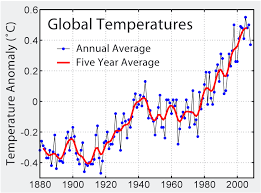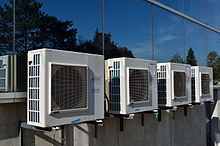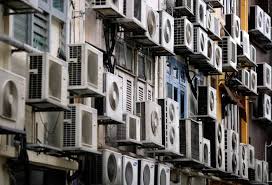Introduction: In the of era of high energy efficiency and sustainability whole world is searching most energy efficient technologies. In this connection all industries have lot of choices, like use of cleaner technologies, CCUS (Carbon capture use & storage), Renewable Energy integration (RE integration) and obviously using low quality heat for chillers & refrigeration. Trigeneration […]
How room air conditioning machines are contributing to Global warming

In present days, due to more warmer days, ACs (Air Conditioner) are very much a part of life. Without ACs no offices will operate comfortably.
In power, chemical, Petrochemical plants and in other manufacturing industries, ACs are playing a crucial role in keeping the surrounding temperature of control systems within permissible limits.
ACs also ensure that the control systems do not malfunction due to warmer environment inside the instrument racks, thus prevention loss of production.
How air conditioners work?
The principle of air conditioning is that “When a liquid converts to a gas, the process is called conversion of phase, it absorbs heat. Air conditioning machines operate in this principle and using specialty chemicals called “Refrigerants”.
Refrigerants change state at a relatively low temperature thus absorbing heat from the space to be cooled. Compressor discharges absorbed heat to outside atmosphere at higher pressure & temperature.
Condensing of the refrigerant brings back the refrigerant to liquid state.
HFCs are contributing to Global Warming
Primarily the refrigerants are HFC(Hydrofluorocarbon) which is one of the six Green House Gases (GHG).
GWP (Global Warming Potential) of common refrigerant HFC gas are ranging from 1200 to 4000. GWP of carbon di-oxide (CO2) is considered as 1.
The more the GWP the more the gas will warm the earth relative to CO2.
Ozone Depletion Potential
The ozone depletion potential (ODP) of a chemical compound is the relative amount of degradation to the ozone layer it can cause, with trichlorofluoromethane (R-11 or CFC-11) being fixed at an ODP of 1.0.
Ozone Depleting Potential of common refrigerants are ranging from 0.02 to 0.283.
Global warming Trend
Apart from the above, if we see the trend of global temperature rise, it has been seen that in 1950 CO2 ppm concentration was approx. 315 ppm and as on Aug 2020, CO2 ppm concentration is approx. 415.
Data mentioned below are from NASA and we must think of this serious situation:
The planet's average surface temperature has risen about 2.05 degrees Fahrenheit (1.14 degrees Celsius) since the late 19th century.
Most of the warming occurred in the past 40 years.
Since 2014 six warmest years on record took place.
2016 was the warmest year on record, but eight months out of that yea, from January through September, with the exception of June, were the warmest on record for those respective months.
Above data shows that how global warming is affecting the world and this requires more usage of ACs.
Hence a small leakage of the refrigerant from the AC circuit will have considerable impact on the environment. As HFCs will trap more heat.

Power consumption by Air conditioners
Generally, 1.5 TR capacity AC machine having 3 star rating will consume average 1100 units (KWh) power annually, considering 1600 Hours of operation in a year.
As per IEA Global energy demand from air conditioners is expected to triple by 2050, requiring new electricity capacity the equivalent to the combined electricity capacity of the United States, the EU and Japan today.
The global stock of air conditioners in buildings will grow to 5.6 billion by 2050, up from 1.6 billion today, which amounts to 10 new ACs sold every second for the next 30 years, according to the report.
The above report shows that how the world energy consumption will increase for air conditioning.
In order to provide the above energy, total power generation has to be increased. This will increase GHG emission.
Govt. of India has taken bold steps to phase out coal-based power plants and increase Renewable Energy to the tune of 175 GW. This will certainly mitigate the high GHG emission.

Importance of increasing energy efficiency of room air conditioners:
In view of the above facts, It is essential that our air conditioners must be used efficiently, in order to save electricity and reduce global warming, by following the following steps ten SUPER steps:
- Set the room temperature at human comfort level, which is between 24 to 25 Deg C.
- When leaving the room for considerable time, turn OFF the AC.
- Use ACs with STAR rating, introduced by BEE (Bureau of Energy Efficiency) India. This will ensure that Minimum Energy Performance Standard (MEPS) is maintained.
- Use Inverter AC technology. In this technology temperature control is achieved by modulating the speed of the compressor as per load demand. This saves approx. 50% energy when compared with non-Inverter AC technology.
- Make sure that no refrigerant leakage happens, during operation and refrigerant re-charging. Please remember that refrigerants have very high Global Warming Potential (GWP).
- If the ambient temperature is comfortable, switch over to a fan. This will save energy.
- Regular servicing of ACs will improve the operating efficiency.
- Ensure that the piping insulation is in place & if distorted, replace the same.
- Repeated “Cycling” is an indication that thermostat is getting faulty. Replace the thermostat as early as possible.
- Ensure that room’s doors & windows are air tight, otherwise AC will be unnecessary loaded and consume more power.
CONCLUSION
Let us take pledge to reduce the GHG emission & carbon footprint reduction in every aspect of human activity.
It is our responsibility to make the earth sustainable so as to make our next generation's life livable & enjoyable.


READ THeSe NEXT
Vapour Absorption Refrigeration System (VARS) opened up an avenue for enhancing energy efficiency. This system is using low quality heat from the process. In thisn process heat lossess are minimized.
The steam surface condenser is the largest heat exchanger in a power plant. Hence the quality of the tubing within the condenser is critical for reliable operation of the plant. Steam turbine condensers play a critical role in the efficiency and performance of power plants, particularly in steam power generation. However, they are not without […]
